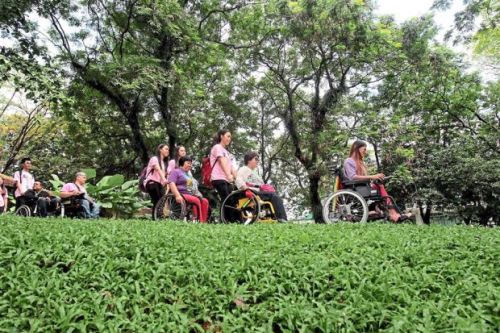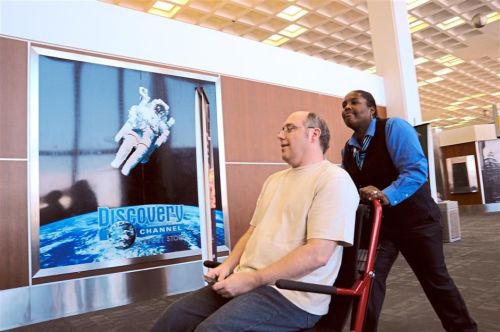 While volunteers are a welcome help, it’s equally important that facilities and buildings are designed in such a way that they can be used independently by tourists with disabilities.
While volunteers are a welcome help, it’s equally important that facilities and buildings are designed in such a way that they can be used independently by tourists with disabilities.
Accessible tourism for people with disabilities, as a business with great potential, might just make the concept flourish. However, seamless co-operation from all relevant parties is also necessary.
The rights for people with disabilities is about “accessibility, dignity and equality; it’s never about charity”, said an elected public official at the launch of the 5th International Conference on Accessible Tourism, referring to the right to barrier-free travel.
The conference was held in Petaling Jaya, Selangor, last December.
It was impossible to not be moved by the hopeful cheers of those in the hall. Most of them were visually impaired or wheelchair-bound. And they comprised people of over 25 nationalities.
What was said at the conference resonated with them. It was about how the fulfilment of their needs was constantly being seen as philanthropy. And their right to unhindered travel.
“We have to consider that tourists with disabilities are customers. However, customers with disabilities are not a segment of their own. They have a purchasing behaviour similar to other tourists, even if travel operators take into account their specific needs,” said Anna Grazia Laura.
Laura is president of the European Network on Accessible Tourism (ENAT).
“A tourist with disabilities is, first of all, a tourist, someone wishing to go on holidays at destinations of his or her choice. And we must consider the fact that they want to see a place of their choice without any hindrance,” she added.
For this to happen, visitors must be ensured uninterrupted accessibility on their travels, from arrival to departure. To ensure a smooth and satisfactory journey, Laura suggested looking at accessible tourism as a business rather than a form of social responsibility.
Accessible tourism, as a business, encompasses four essentials – information, transport, infrastructure and services – which must be delivered by travel operators and destinations throughout the entire duration of the person’s holiday.
 Ramps along the beach in Kapiti Island, New Zealand, is an example of amenities that help promote accessible tourism
Ramps along the beach in Kapiti Island, New Zealand, is an example of amenities that help promote accessible tourism
However, Joseph Kwan, the global chair of the International Commission on Technology and Accessibility (Rehabilitation International), said there are other areas that must be addressed concerning tourism for people with disabilities.
“The relevant parties have to take all appropriate measures to ensure that people with disabilities have access, in terms of equal opportunities, to locations providing a service or cultural events, such as theatres, museums, cinemas, libraries and tourism services and as far as possible, access to monuments and sites of national cultural importance,” the experienced architect and access consultant offered.
“Tourism stakeholders should identify the current status of infrastructures in cities. Remove any obstacles that hinder or even prevent the travel of those with disabilities,” he added.
Kwan agreed that while businesses play a role in developing this market, participation from government bodies is crucial.
 The human touch, such as mobility assistance from an airport employee, can also contribute to a barrier-free travel for tourists with disabilities.
The human touch, such as mobility assistance from an airport employee, can also contribute to a barrier-free travel for tourists with disabilities.
“The Tourism Ministry has to consider tourism as a sustainable economic activity with an important role in generating employment and foreign exchange,” he said.
Kwan stressed the need to develop an effective policy for inclusive tourism, with emphasis on knowing the profiles of current and potential tourists with disabilities.
Laura noted that the various relevant bodies should come together to make accessible tourism feasible.
“NGOs are vital. They could promote and provide education in regard to tourists with disabilities. They will have a better understanding of what these customers might need. The travel operators’ job is to design suitable packages whereas governmental bodies should be there to facilitate,” she offered.
“The roles of social organisations, public administrations and economic operators should be clearly defined,” Laura added.
The upcoming audio descriptive guided walks at the heritage trails in George Town, Penang, are proof that accessible tourism is possible with co-operation from the various stakeholders. This is a joint effort by the National Council for the Blind Malaysia (NCBM), George Town World Heritage Incorporated (GTWHI), and Friends of George Town Heritage (FoGTH).
“Audio description often refers to art forms and not tourism. With this project in George Town, we want to change that and include this service to heritage buildings. This will make the Unesco World Heritage Site accessible to visually impaired people,” said NCBM Centre for Accessibility manager Wong Yoon Loong.
 When it comes to accessible tourism, travel operators must ensure that there are no barriers to prevent a disabled person’s journey. This includes the right transportation
When it comes to accessible tourism, travel operators must ensure that there are no barriers to prevent a disabled person’s journey. This includes the right transportation
NCBM will provide training in audio description for visually impaired persons whereas the state-owned GTWHI will provide administrative assistance and support. As for FoGTH, its group of trained and certified volunteers will design a special three-hour heritage walk through the island.
Wong said the project will be launched during the Unesco World Heritage Cele-bration for George Town in July, with evaluation and development of new heritage trails by the end of the year.
“Depending on the public’s response, we will see if we can extend this project to other parts of Malaysia in 2016,” said Wong.
According to Beautiful Gate Foundation for the Disabled executive director Sia Siew Chin, encouraging response from the government is integral in making accessible tourism a widespread concept in any destination. Thus far, she notes, the state governments in Penang and Selangor have been particularly receptive to the concept of accessibility.
Beautiful Gate Foundation, which co-organised this conference, will submit to the Tourism Ministry a list of resolutions drafted at the event. The recommended measures include reviewing all tourism policies, adopting internationally recognised universal design standards for buildings, and promoting guidelines for accessible information, and signages.
Kwan pointed out that travel and full access to tourist activities, services and facilities are a right enshrined in Article 9 and Article 30 of the United Nations Convention on the Rights of Persons with Disabilities.
“Besides, making facilities and tourist services more accessible to people with disabilities can represent a great opportunity to attract a greater number of consumers to the tourism sector,” Kwan concluded.
Source: The Star




Deixe um comentário